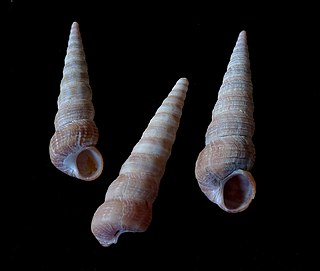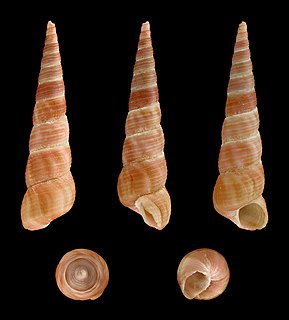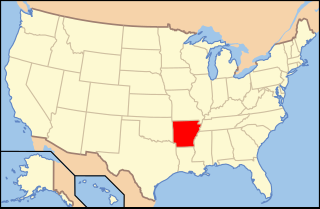
Gryphaea, common name devil's toenails, is a genus of extinct oysters, marine bivalve mollusks in the family Gryphaeidae.

A spire is a part of the coiled shell of molluscs. The spire consists of all of the whorls except for the body whorl. Each spire whorl represents a rotation of 360°. A spire is part of the shell of a snail, a gastropod mollusc, a gastropod shell, and also the whorls of the shell in ammonites, which are fossil shelled cephalopods.

Turritella is a genus of medium-sized sea snails with an operculum, marine gastropod mollusks in the family Turritellidae.

The Aquia Formation is a geologic sandstone formation that extends from the upper Chesapeake Bay to the James River near Hopewell, Virginia. It consists of clayey, silty, very shelly, glauconitic sand. Fossil records indicate that this stratigraphic unit was created during the Paleocene.

Turritellidae, common name the "tower shells" or "tower snails", is a taxonomic family of small to medium-sized sea snails, marine gastropod molluscs in the clade Sorbeoconcha.

Turritella communis, common name the "common tower shell" is a species of medium-sized sea snails with an operculum, marine gastropod mollusks in the family Turritellidae.

Elimia tenera, formerly known as Goniobasis tenera, is an extinct species of freshwater snail with an operculum, in the aquatic gastropod mollusk family Pleuroceridae. This species flourished during the Eocene and is now known only from the fossil record.

The Tamiami Formation is a Late Miocene to Pliocene geologic formation in the southwest Florida peninsula.

Turritella vermicularis is an extinct species of sea snail, a marine gastropod mollusk in the family Turritellidae.

Paleontology in Arkansas refers to paleontological research occurring within or conducted by people from the U.S. state of Arkansas. The fossil record of Arkansas spans from the Ordovician to the Eocene. Nearly all of the state's fossils have come from ancient invertebrate life. During the early Paleozoic, much of Arkansas was covered by seawater. This sea would come to be home to creatures including Archimedes, brachiopods, and conodonts. This sea would begin its withdrawal during the Carboniferous, and by the Permian the entire state was dry land. Terrestrial conditions continued into the Triassic, but during the Jurassic, another sea encroached into the state's southern half. During the Cretaceous the state was still covered by seawater and home to marine invertebrates such as Belemnitella. On land the state was home to long necked sauropod dinosaurs, who left behind footprints and ostrich dinosaurs such as Arkansaurus.

Cheuquemó Formation is a geological formation of sedimentary rock in south-central Chile. The sediments of the formation were deposited during the Late Oligocene and Early Miocene epochs. The formations lower sections are made up of conglomerate, then successions of sandstone, tuff and mudstone rich in organic material follows. The formation indicates that sedimentation occurred in an estuarine (paralic) and other non-marine (continental) environments. It contains fossils of the following genera: Mytilus, Cardium and Turritella. Stratigraphically it overlies the Bahía Mansa Metamorphic Complex and underlies the Miocene Santo Domingo Formation.
Archimediella is a genus of sea snails, marine gastropod mollusks in the family Turritellidae.











